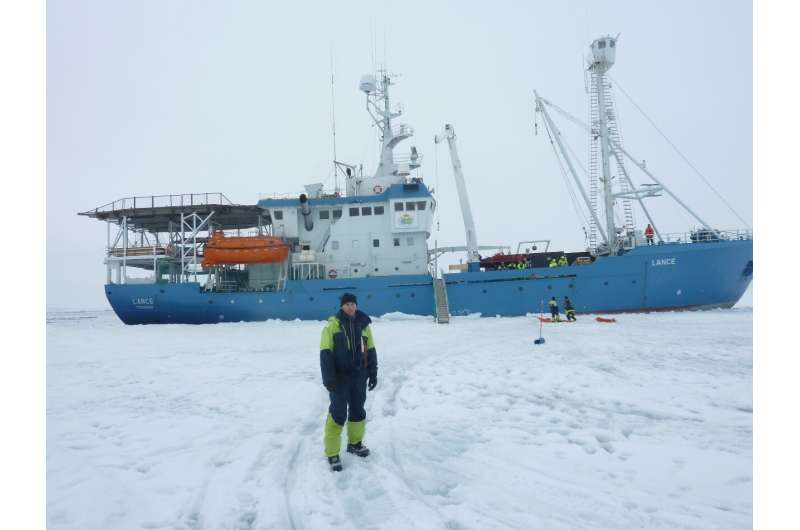New model enhances wave forecasting in ice-covered waters
A research paper published in Advances in Atmospheric Sciences sheds light on the relationship between sea ice thickness and wind wave modules in the marginal ice zone. The study introduces a parameterization scheme that incorporates the role of sea ice thickness in understanding wave dynamics and their interactions with sea ice.
Conducted by a team of scientists from Sun Yat-sen University, Southern Marine Science and Engineering Guangdong Laboratory (Zhuhai), Dalian Maritime University, SINTEF Ocean, and Norwegian University of Science and Technology, the study focuses on the intricate interplay between wind waves and sea ice. By developing a novel parameterization scheme, the researchers aim to enhance our understanding of wave climates and ice dynamics, with wide-ranging implications for oceanography, climate research, and marine operations in ice-covered areas.
“The new scheme enables more accurate wave forecasts in the marginal ice zone, benefiting navigation safety, oil spill responses, and other activities in ice-covered waters,” said Dongang Liu, lead author from Dalian Maritime University. The scheme addresses limitations of previous models that either overlooked sea ice cover or lacked sensitivity to ice thickness.
To validate the model, the researchers compared it against existing models and buoy data from the Barents Sea. Andrei Tsarau, currently affiliated with SINTEF, provided the data. The results demonstrated that the new model more effectively captures the directional attenuation and spreading of waves caused by sea ice. Future work will focus on optimizing and expanding the applicability of the scheme.
The sea ice augmented wave model will revolutionize wave forecasting and monitoring in ice-infested waters. By accounting for sea ice thickness, the model provides valuable insights into wave energy dissipation and ice break-up in the marginal ice zone. These findings have the potential to enhance predictive models for wave climates in ice-covered regions, leading to improved safety and operational efficiency.
“The marginal ice zone is a dynamic environment with complex interactions between wind waves and sea ice,” explained co-author Qinghua Yang. “Our research advances our understanding of these interactions and lays the foundation for future studies and applications.”
The findings of this study have practical implications for ice management strategies and offshore operations, enabling informed decision-making and risk mitigation in ice-covered regions. Additionally, they contribute to a broader understanding of ocean processes in the marginal ice zone, which is crucial for addressing the challenges posed by climate change and its impact on sea ice.
More information:
Dongang Liu et al, A Parameterization Scheme for Wind Wave Modules that Includes the Sea Ice Thickness in the Marginal Ice Zone, Advances in Atmospheric Sciences (2023). DOI: 10.1007/s00376-023-2188-5
Citation:
New model enhances wave forecasting in ice-covered waters (2023, June 7)
retrieved 7 June 2023
from https://phys.org/news/2023-06-ice-covered.html
This document is subject to copyright. Apart from any fair dealing for the purpose of private study or research, no
part may be reproduced without the written permission. The content is provided for information purposes only.

A research paper published in Advances in Atmospheric Sciences sheds light on the relationship between sea ice thickness and wind wave modules in the marginal ice zone. The study introduces a parameterization scheme that incorporates the role of sea ice thickness in understanding wave dynamics and their interactions with sea ice.
Conducted by a team of scientists from Sun Yat-sen University, Southern Marine Science and Engineering Guangdong Laboratory (Zhuhai), Dalian Maritime University, SINTEF Ocean, and Norwegian University of Science and Technology, the study focuses on the intricate interplay between wind waves and sea ice. By developing a novel parameterization scheme, the researchers aim to enhance our understanding of wave climates and ice dynamics, with wide-ranging implications for oceanography, climate research, and marine operations in ice-covered areas.
“The new scheme enables more accurate wave forecasts in the marginal ice zone, benefiting navigation safety, oil spill responses, and other activities in ice-covered waters,” said Dongang Liu, lead author from Dalian Maritime University. The scheme addresses limitations of previous models that either overlooked sea ice cover or lacked sensitivity to ice thickness.
To validate the model, the researchers compared it against existing models and buoy data from the Barents Sea. Andrei Tsarau, currently affiliated with SINTEF, provided the data. The results demonstrated that the new model more effectively captures the directional attenuation and spreading of waves caused by sea ice. Future work will focus on optimizing and expanding the applicability of the scheme.
The sea ice augmented wave model will revolutionize wave forecasting and monitoring in ice-infested waters. By accounting for sea ice thickness, the model provides valuable insights into wave energy dissipation and ice break-up in the marginal ice zone. These findings have the potential to enhance predictive models for wave climates in ice-covered regions, leading to improved safety and operational efficiency.
“The marginal ice zone is a dynamic environment with complex interactions between wind waves and sea ice,” explained co-author Qinghua Yang. “Our research advances our understanding of these interactions and lays the foundation for future studies and applications.”
The findings of this study have practical implications for ice management strategies and offshore operations, enabling informed decision-making and risk mitigation in ice-covered regions. Additionally, they contribute to a broader understanding of ocean processes in the marginal ice zone, which is crucial for addressing the challenges posed by climate change and its impact on sea ice.
More information:
Dongang Liu et al, A Parameterization Scheme for Wind Wave Modules that Includes the Sea Ice Thickness in the Marginal Ice Zone, Advances in Atmospheric Sciences (2023). DOI: 10.1007/s00376-023-2188-5
Citation:
New model enhances wave forecasting in ice-covered waters (2023, June 7)
retrieved 7 June 2023
from https://phys.org/news/2023-06-ice-covered.html
This document is subject to copyright. Apart from any fair dealing for the purpose of private study or research, no
part may be reproduced without the written permission. The content is provided for information purposes only.
